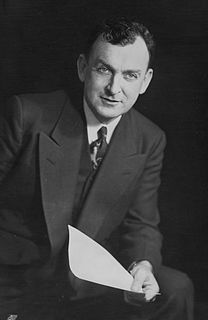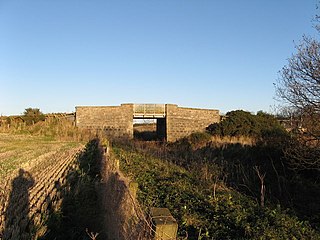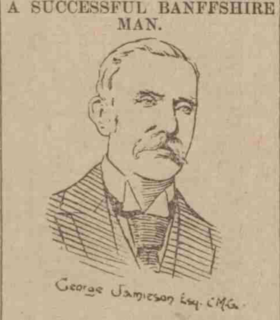
Moray Scottish Gaelic: Moireibh or Moireabh) is one of the 32 local government council areas of Scotland. It lies in the north-east of the country, with a coastline on the Moray Firth, and borders the council areas of Aberdeenshire and Highland.

Dufftown is a burgh in Moray, Scotland. While the town is part of the historic Mortlach parish, the town was established and laid out in the early 19th century as part of a planned new town settlement. The town has several listed 19th century buildings and serves as a regional centre for agriculture, tourism and services. The town is well known for its whisky based economy, as it produces more whisky than any other town in Scotland and is home to several existing and former distilleries.

Burghead is a small town in Moray, Scotland, about 8 miles (13 km) north-west of Elgin. The town is mainly built on a peninsula that projects north-westward into the Moray Firth, surrounding it by water on three sides. People from Burghead are called Brochers.

Moray; or Morayshire, called Elginshire until 1919, is a historic county, registration county and lieutenancy area of Scotland, bordering Nairnshire to the west, Inverness-shire to the south, and Banffshire to the east. It was a local government county, with Elgin the county town, until 1975. The county was officially called Elginshire, sharing the name of the Elginshire parliamentary constituency, so named since 1708.

Banffshire ; Scots: Coontie o Banffshire; Scottish Gaelic: Siorrachd Bhanbh) is a historic county, registration county and lieutenancy area of Scotland. The county town is Banff, although the largest settlement is Buckie to the west. It borders the Moray Firth to the north, Morayshire and Inverness-shire to the west, and Aberdeenshire to the east and south.

Keith is a small town in the Moray council area in north east Scotland. It has a population of 4,734.

Moray is a county constituency of the House of Commons of the Parliament of the United Kingdom. It elects one Member of Parliament (MP) by the first past the post system of election.

Moray is a constituency of the Scottish Parliament (Holyrood) covering most of the council area of Moray. It elects one Member of the Scottish Parliament (MSP) by the first past the post method of election. It is also one of eight constituencies within the Highlands and Islands electoral region, which elects seven additional members, in addition to the eight constituency MSPs, to produce a form of proportional representation for the region as a whole.

James Sinclair, was a Canadian politician and businessman. He was the maternal grandfather of current Canadian Prime Minister Justin Trudeau.

Banffshire and Buchan Coast is a constituency of the Scottish Parliament (Holyrood) covering parts of the council areas of Aberdeenshire and Moray. It elects one Member of the Scottish Parliament (MSP) by the first past the post method of election. It is one also of ten constituencies in the North East Scotland electoral region, which elects seven additional members, in addition to ten constituency MSPs, to produce a form of proportional representation for the region as a whole.
The Banff, Portsoy and Strathisla Railway was a Scottish railway company that connected the Aberdeenshire ports of Banff and Portsoy with the main line of the Great North of Scotland Railway (GNoSR) main line at Grange, a place some distance east of Keith. The railway opened in 1859, and was renamed the Banffshire Railway in 1863 when the GNoSR began running services.

Grange railway station was a railway station in the parish of Grange, historically in Banffshire. Opened in 1856 by the Great North of Scotland Railway, three years later it became a junction station after the Banff, Portsoy and Strathisla Railway built a branch to Banff and Portsoy.

Tillynaught railway station or Tillynaught Junction was a junction railway station in what is now Aberdeenshire, Parish of Fordyce, 6 miles south-west of Banff. Tillynaught was opened in 1859 by the Banff, Portsoy and Strathisla Railway, and in 1867 was absorbed by the Great North of Scotland Railway(GNSR). This junction station was served by Aberdeen to Elgin trains as well as trains running to the branch terminus at Banff.

George Jamieson CMG (1843-1920) was a British diplomat and judge who served in China. His last position before retirement from government service was as British Consul-General in Shanghai.
Cornhill railway station was an intermediate stop situated on the Great North of Scotland Railway (GNoSR) line from Cairnie Junction to Tillynaught. There was only a single platform at Cornhill that served the nearby village that lies in Fordyce Parish, of what was once Banffshire, 8+1⁄2 miles (13.7 km) from Banff itself. The line ran to Tillynaught where it split to reach Banff by a branch line or Elgin by the Moray Coast line.

Glenbarry railway station, previously known as Barry was an intermediate stop with a passing loop situated on the Great North of Scotland Railway (GNoSR) line from Cairnie Junction to Tillynaught. There were two platforms at Glenbarry that served the nearby hamlet that lies in what was once Banffshire. The line northwards ran to Tillynaught where it split to reach Banff by a branch line or Elgin by the Moray Coast line.
Knock railway station was an intermediate stop situated on the Great North of Scotland Railway (GNoSR) line from Grange and Cairnie Junction to Tillynaught. Knock served the rural community and later the Knockdhu Distillery in Banffshire. The line northwards ran to Tillynaught where it split to reach Banff by a branch line or Elgin by the Moray Coast line.

Millegin railway station, Millagan railway station or later Millegin Siding was briefly an intermediate stop situated on what became the Great North of Scotland Railway (GNoSR) line from Grange and Cairnie Junction to Tillynaught. Millegin served the rural community and the nearby saw mill in Banffshire. The line northwards ran to Tillynaught where it split to reach Banff by a branch line or Elgin by the Moray Coast line.

Prof Andrew Jamieson CE FRSE (1849–1912) was a Scottish engineer and academic author.

St Rufus Church, also known as Keith Parish Church, is a Church of Scotland church in Keith, Moray, that was built in 1816. Designed by James Gillespie Graham in the Perpendicular Gothic style, it has crenellated walls, traceried windows and a tall bell and clock tower at its west end. The doorway leading into the nave from the entrance lobby is an unusual war memorial, listing the names of parishioners who died in the First World War on one side, and in the Second World War on the other.



















